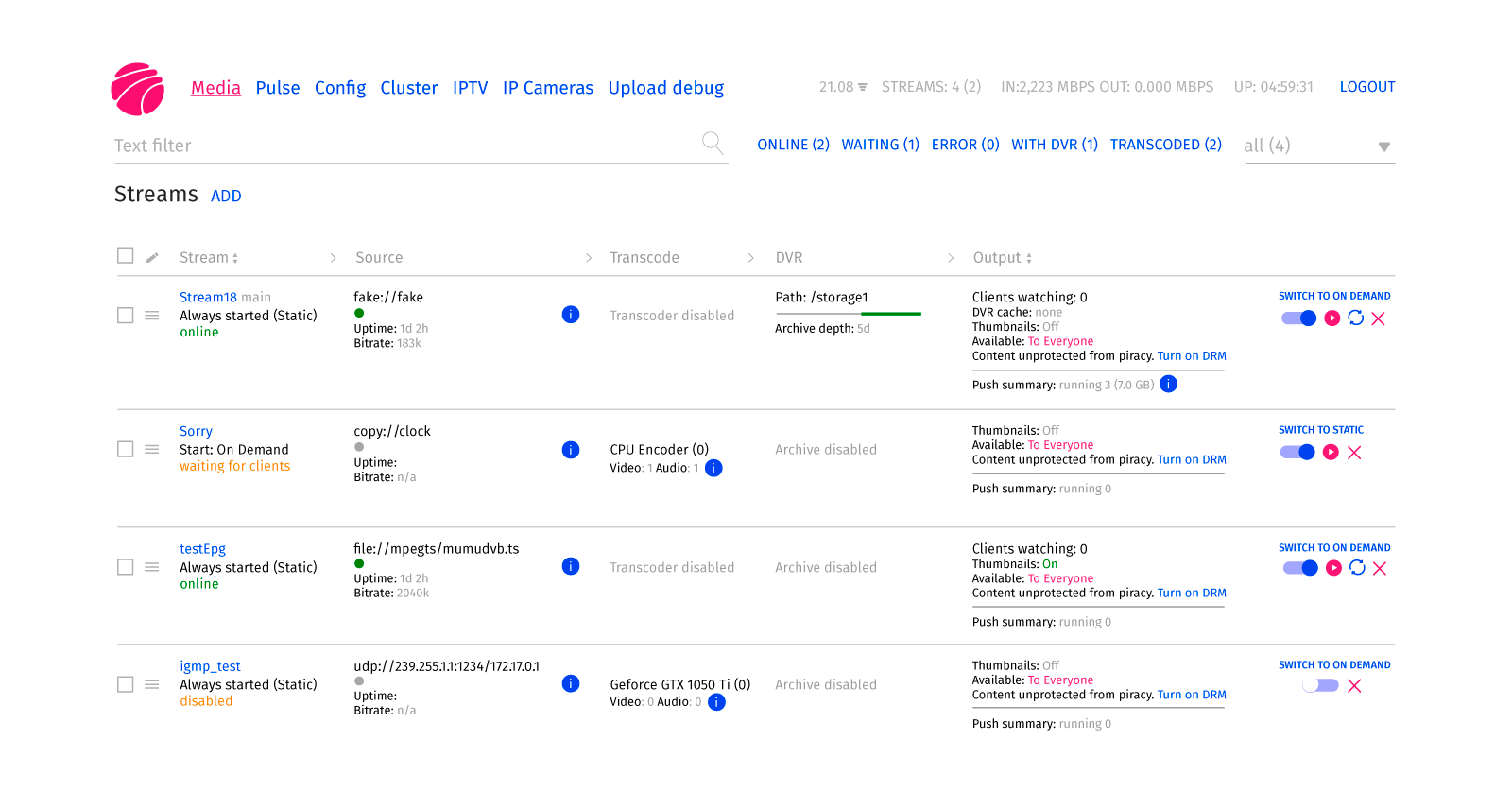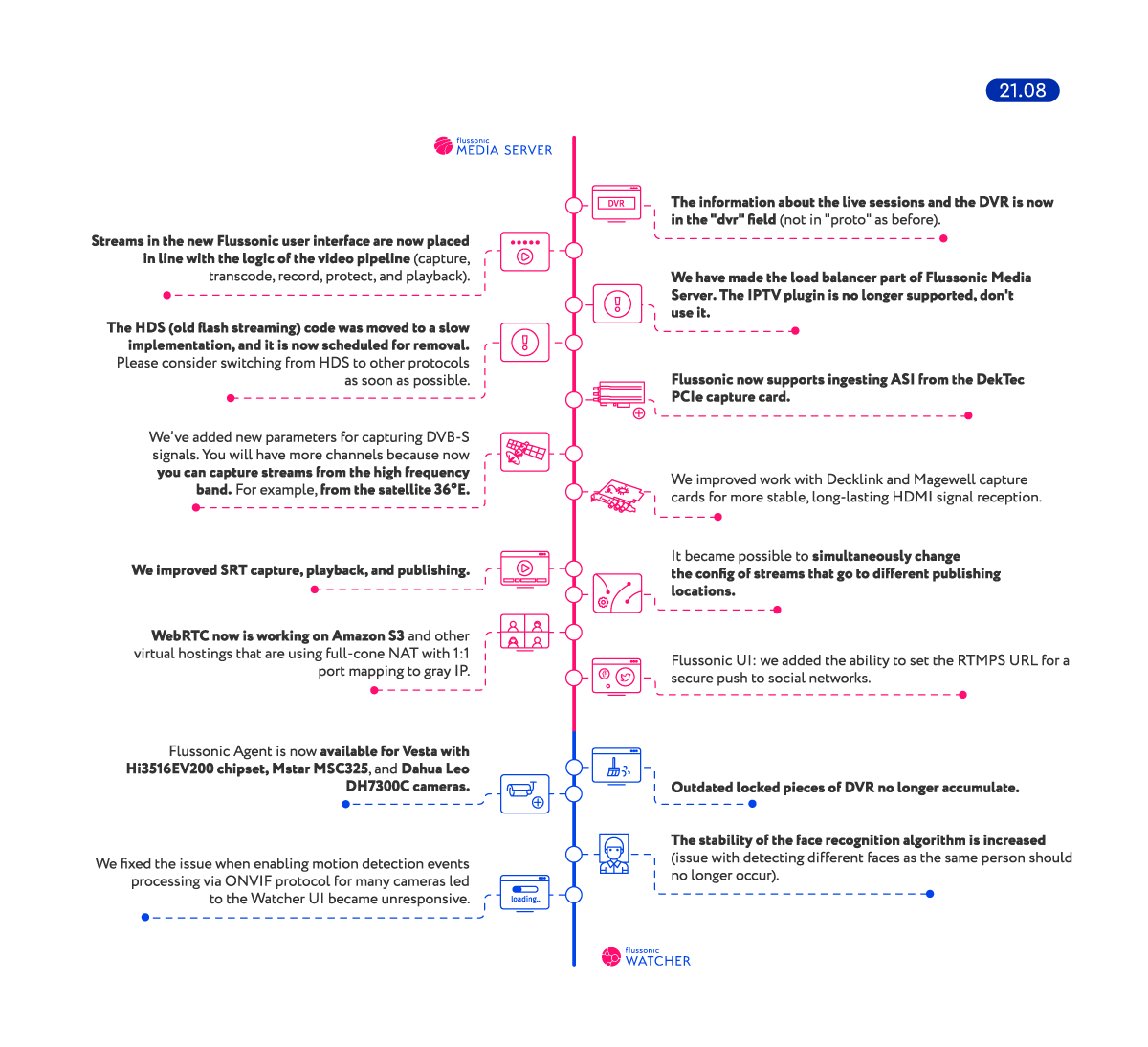21.08
-
Flussonic Agent is now available for Vesta with Hi3516EV200 chipset, Mstar MSC325, and Dahua Leo DH7300C cameras.
-
Outdated locked pieces of DVR no longer accumulate.
-
We fixed the issue when enabling motion detection events processing via ONVIF protocol for many cameras led to the Watcher UI became unresponsive.
-
The stability of the face recognition algorithm is increased (issue with detecting different faces as the same person should no longer occur).
What’s new in Flussonic ver. 21.08

-
Streams in the new Flussonic user interface are now placed in line with the logic of the video path (capture, transcode, record, protect, and playback). On one page, for each stream, you can immediately see:
- the number and quantity of video and audio tracks, the resolution, codec, and bit rate,
- on which card the stream is transcoded,
- if the DVR system, authorization, and DRM, etc. are enabled or not,
- the DVR location and consumption,
- if the DVR cache and thumbnails are enabled or not,
- how many clients are currently online.
-
The information about the live sessions and the DVR is now in the “dvr” field (not in “proto” as before). Pay special attention to this change if you are one of those who collect statistics during sessions. Example of JSON response if it is a DVR session –
proto: hls,dvr: true(notproto: hls_dvras before). Example of JSON response if it is a live session –proto: hls,dvr: false(not justproto: hlsas before). -
The HDS (old flash streaming) code was moved to a slow implementation, and it is now scheduled for removal (the development of HDS ended years ago; the Flash Player that plays it is hardly supported by browsers). Please consider switching from HDS to [other protocols] as soon as possible.
-
It is no longer necessary to install an IPTV plugin for load balancing. We have made the load balancer part of Flussonic Media Server (see how to configure it now), so Flussonic is fully responsible for balancing. The IPTV plugin is no longer supported, please don’t use it. In addition, we have implemented the load balancer in such a way as to make it compatible with the geobalancer in the new Catena (which is coming in the Fall 2021).
-
We’ve added new parameters for capturing DVB-S signals. You will have more channels because now you can capture streams from the high frequency band. For example, from the satellite 36°E.
-
It became possible to simultaneously change the config of streams that go to different publishing locations. We combine templates for dynamic and static streams into one design. In this case, a prefix is created in the template. Thus, configuration changes (e.g. transcoding profile) are applied simultaneously to all streams, reducing the manual control involved in server management.
-
Flussonic now supports ingesting ASI from the DekTec PCIe capture card.
-
Flussonic now supports pushing SRT streams. Also, we have improved SRT capture, playback, and publishing. There was a multiplex mode in the earlier version. Now, we have implemented a one-channel mode which is more common. Thus, you can specify separate ports for playback and publishing for each stream, and receive different SRT streams from the same port. Now you can set additional options when setting up publishing, playing, and capturing SRT (connection timeout, latency, etc.). In addition, we have simplified the SRT testing procedure: using the built-in utility, Flussonic can generate an SRT stream.
-
[WebRTC] now is working on Amazon S3 and other virtual hostings that are using full-cone NAT with 1:1 port mapping to gray IP.
-
We improved work with Decklink and Magewell capture cards for more stable, long-lasting HDMI signal reception.
-
Issues with redirecting in backend authorization, returning
HTTP 404 Not foundinstead ofHTTP 302 Found, are fixed. Now the client is redirected to the target URL. -
In one of our previous releases, we solved a client issue by developing a single-period manifest to play DASH. (The multi-period manifest is not supported by some set-top boxes and other legacy devices, but these are still used in many parts of the world.) Therefore, the operators did not find it necessary to replace these devices. Now, in version 21.08, we have improved the handling of requests with the
period = monooption enabled for a DVR playback. -
Live player controls are hiding anew on mobile devices, a few seconds after the stream playback start.
-
Flussonic UI:
- We fixed the configuration error after updating the configuration for a group of streams sourced fromplaylist://
- Language and subtitles settings are now displayed for TS and MP4 files as well as for MPEG-TS streams.
- The EPG display in the EPG stream section when using authorization (the “auth” option) is restored.
- We added the ability to set the RTMPS URL for a secure push to social networks.
